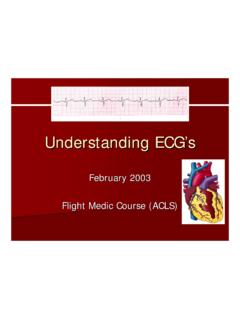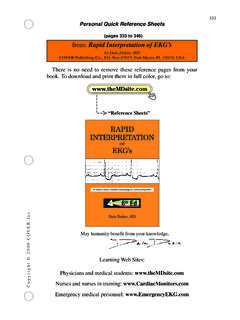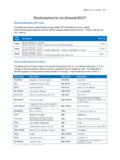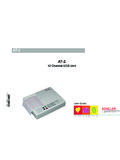Transcription of SCST Diploma in ECG Interpretation: required …
1 1 SCST Diploma in ecg interpretation : required knowledge and skills The Society makes this award to candidates who can demonstrate the ability to recognise a broad range of adult electrocardiographic patterns under examination conditions. This is designed as an intermediate level award for all healthcare professionals who wish to demonstrate skills and knowledge in ecg interpretation . Candidates will be expected to demonstrate the following outcomes in a written examination: Cardiac anatomy and physiology knowledge of the structure and function of the cardiac conduction system.
2 An understanding of the origin and spread of electrical impulses through the heart. An understanding of cellular depolarisation and repolarisation. knowledge of the gross anatomy of the heart and its position and orientation within the thorax. An understanding of automaticity and refractoriness. Pathophysiology An understanding of what is meant by ischaemia, infarction and necrosis. knowledge of the defining features of stable angina, unstable angina, Prinzmetal angina, NSTEMI and STEMI. An understanding of hypertrophy and dilatation and their causes.
3 A knowledge of how various non-cardiac conditions, eg COPD and renal failure, can result in abnormal ECG features. Electrocardiographic principles Relationship of the electrocardiogram to the electrical events of the heart Relationship of the electrical events to the mechanical events of the cardiac cycle knowledge of the derivation of all 12 leads of the standard ECG and their orientation with regard to one another and the heart. An understanding of the function of the neutral (right leg) electrode. knowledge of the terminology of all the waveform deflections.
4 The ability to work out the mean frontal plane QRS axis within 15 degrees of accuracy. The ability to measure all standard intervals and amplitudes. The ability to apply Bazett s formula for the correction of the QT interval. Normal ECG knowledge of the features of a normal ECG. An understanding of normal variations due to age, ethnicity, athletic training, bodily build and state of activity. 2 The ability to recognise sinus rhythm, sinus tachycardia, sinus bradycardia and sinus arrhythmia and to demonstrate knowledge of the circumstances in which each is considered appropriate.
5 knowledge of the normal range of values for the commonly measured time intervals and amplitudes. An understanding of the normal R:S ratio progression in the chest leads. The ability to recognise common errors of electrode connection and positioning knowledge of the causes and features of different kinds of artefact The ability to distinguish between artefact and genuine ECG features Supraventricular arrhythmias The ability to recognise normally conducted, aberrantly conducted and non-conducted atrial premature beats. knowledge of the features that help to distinguish between atrial tachycardia, atrioventricular re-entrant tachycardia and atrioventricular nodal re-entrant tachycardia.
6 The ability to recognise atrial flutter with 1:1 conduction, 2:1 conduction, 3:1 block, 4:1 block and complete AV block. The ability to recognise atrial fibrillation with slow and fast ventricular response; with fine and coarse baselines; with pre-excitation via an accessory pathway; and with complete AV block. knowledge of the identifying features of accelerated AV nodal rhythm with or without AV dissociation. Bradyarrhythmias and conduction disturbances The ability to differentiate between sinus pauses, sinus arrest and sino-atrial block knowledge of the ECG criteria for left anterior fascicular block, left posterior fascicular block, incomplete right bundle branch block, complete right bundle block and left bundle branch block.
7 The ability to recognise all categories of atrioventricular block and determine whether block is likely to be AV nodal or infra-Hisian. The ability to distinguish between AV nodal and ventricular escape beats and to recognise the presence of an escape rhythm. Ventricular arrhythmias The ability to recognise ventricular premature beats and distinguish them from atrial premature beats. An understanding of post-VPB compensatory pauses and interpolated VPBs. An ability to recognise ventricular bigeminy, ventricular trigeminy, ventricular couplets and ventricular triplets.
8 The ability to recognise accelerated idioventricular rhythm with and without retrograde conduction. The ability to recognise ventricular tachycardia and a knowledge of the characteristics which help to distinguish VT from SVT. An understanding that some varieties of VT are not-life-threatening. knowledge of the typical features of right ventricular outflow tract VT. 3 Cardiac morphological abnormalities The ability to diagnose left and right ventricular hypertrophy by the Sokolow-Lyon criteria and to be aware of the possible clinical causes of these conditions.
9 An understanding of the ECG features of left atrial abnormality and right atrial abnormality . An understanding of the limitations of the ECG in diagnosing ventricular hypertrophy. knowledge of the ECG characteristics of hypertrophic cardiomyopathy, dilated cardiomyopathy, cardiac amyloidosis and arrhythmogenic right ventricular cardiomyopathy and the ability to make a differential diagnosis based on the conjunction of clinical and ECG features. The ability to recognise the features of ventricular pre-excitation, and knowledge of the anatomical basis of the condition and the possible clinical consequences of it.
10 An ability to identify the ECG features of dextrocardia and distinguish dextrocardia from other causes of a right axis deviation. A knowledge of the ECG patterns associated with primum and secundum atrial septal defects. Neurological and neuromuscular abnormalities An understanding of the ECG abnormalities associated with stroke, sub-arachnoid haemorrhage and muscular dystrophy. An understanding of the importance of the clinical context in interpreting the ECG changes associated with the above conditions. Metabolic, endocrine and electrolyte abnormalities knowledge of the ECG features of hypothermia.
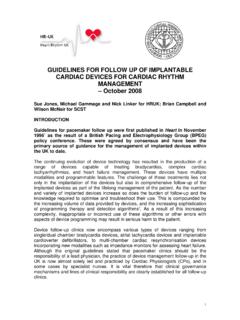
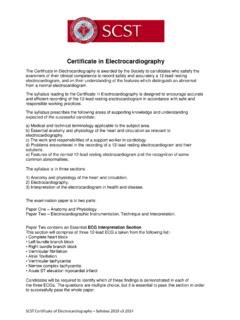



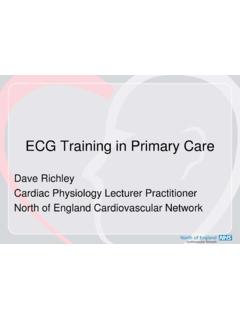
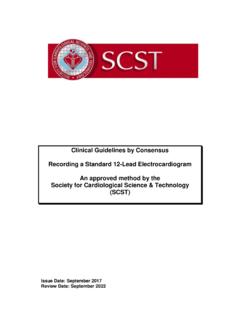
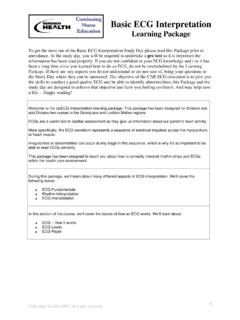
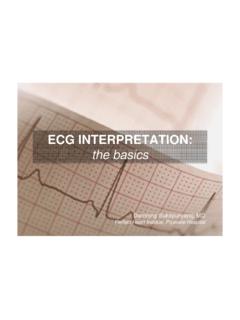
![ECG Interpretation -JPC-PA [Mode de compatibilité]](/cache/preview/e/6/1/8/b/5/9/7/thumb-e618b597b0b1fc3eb9eb9fd2fe396453.jpg)
